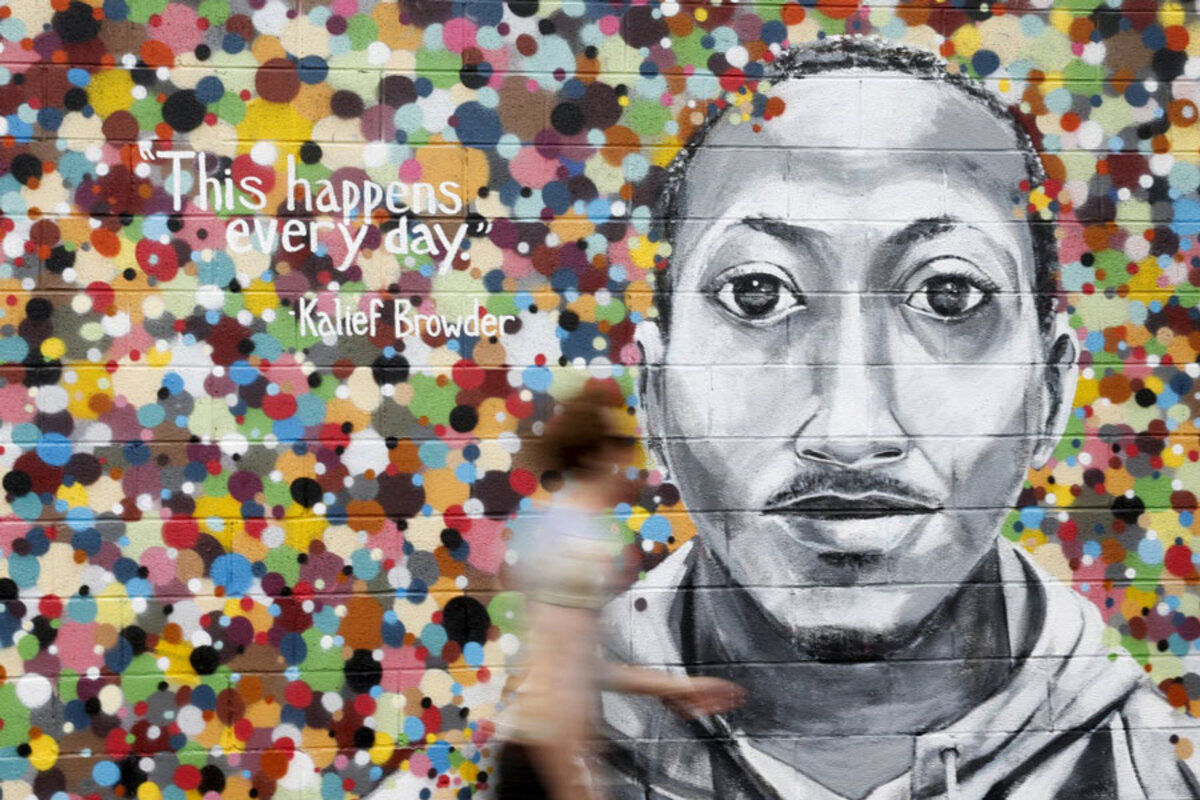Get out of jail free: US cities eye bail reform, other efforts to help poor
Loading...
Mitch Lucas, the assistant sheriff for Charleston County, drives past the lot where Walter Scott was killed every day.
Mr. Scott made it just a few yards across an empty lot in North Charleston, S.C., in April before he was shot multiple times in the back by Michael Slager, the police officer who pulled him over for a broken tail light.
âThatâs one of the most disturbing things Iâve ever watched,â Assistant Sheriff Lucas says of the bystander video that led to Mr. Slager being charged with Scottâs murder.
For Scott, a father of four who worked as a forklift operator, a fear of being jailed due to missed child support payments drove him to a flee a traffic stop that day, his relatives said. According to Charleston County records he owed more than $18,000 in child support and court fees, and had last paid child support in 2012. He had been in jail three times since 2008.
âHe had trouble keeping up with the payments, thatâs all,â Rodney Scott, his older brother, told . âHe knew he would go to jail.â
In a tragic irony, Charleston is one of the cities at the vanguard of efforts to reform the jail system, so that people are not held for months without being convicted of a crime after being arrested for nonviolent offenses.
Americaâs national conversation on race and inequality has reached a crescendo over the past year, and the countryâs criminal justice system is at the center of it. Few institutions embody the countryâs issues of racial and economic inequality more starkly, and recent tragedies have amplified calls for reform on both sides of the political aisle.
For those able to afford bail, jail might mean a few hours or a night behind bars. But for low-income Americans, an overcrowded system means an average of 23 days in jail before they get a court date. In the most extreme cases, people have waited for years before their cases were resolved. During that time, advocates for reform say, they are separated from their families. They could lose their jobs. If they decide to get out by pleading guilty, they would then have a criminal conviction, which would hamper their efforts to reintegrate into society, limiting access to jobs, housing, even a driverâs license.
âJails are where the problems of mass incarceration begin,â says Julian Adler, director of research-practice strategies at the Center for Court Innovation. âPrison reform is very important, but if you donât focus on how America uses and overuses jail youâre really missing that threshold moment where mass incarceration begins.â
After decades as a political third rail, both major parties are now getting behind criminal justice reform. Years of tough-on-crime policy have  beyond their breaking point, costing the country billions of dollars while the countryâs poor and minority citizens. President Obama became the first sitting US president to visit a federal prison earlier this month and commuting the sentences of 46 nonviolent drug offenders.
But for some experts reforming the jail system is as important, if not more important.Â
There are almost 12 million local jail admissions every year â 20 times the number of prison admissions â according to a report from the . Jail populations have tripled since the 1980s, with nearly 75 percent of sentenced offenders and pretrial detainees in jail for nonviolent offenses.
The average length of stay in jail has also increased from 14 days to 23 days, and the longer a person remains in jail, the more the consequences can be exacerbated. Studies have shown that as the length of time in pretrial detention increases, so does the likelihood of recidivism within one or two years.
An arrest, Lucas says, âcreates almost a hurricane event, and the person arrested is at the eye of the storm and everything else is flying around out of control.âÂ
An arrest not only disrupts the individualâs life, he adds, but their whole family as well. The family â perhaps already under financial pressure â not only has one less earner in the house, but often has to rustle up money for bail.
Experts hope that if the jail system can be reformed â specifically if it can be made cheaper and more efficient, and rely less on human judgment for potentially life-altering decisions â then there could be significant downstream benefits for the entire criminal justice system.
Local jurisdictions, from large cities to small rural counties, are already taking steps to reduce overcrowding and what critics call a disparate impact on low-income and minority Americans.
Reducing jail populations boils down to two core changes, experts say: reducing the number of arrests for minor infractions, and relaxing or eliminating monetary requirements for jail release. Reforming bail is one tool to reduce the number of people in jail who aren't a threat to the public, but it's not the only option.
- Money bonds are illegal in Washington, D.C., for example. Courts there release 85 percent of all those arrested on their own recognizance; the other 15 percent are deemed too dangerous or unlikely to return if released. About 88 percent of those released appear for their day in court, according to the . Of the no-shows, of those re-arrested, less than 1 percent are alleged to have committed a violent crime.
- Illinois lawmakers passed a bill in May â proposed by the Cook County sheriff â that would release inmates accused of nonviolent crimes without bond, pending trial, if their case has not been resolved within 30 days.
- New York is pursuing . The city is eliminating monetary bail for some low-level offenders, and it is working to reduce its case backlog that has kept some arrestees in jail for more than two years without a conviction. The city also has banned solitary confinement for all inmates who are under 21 years old.
- Other cities, from Los Angeles to Portland, Maine, are partnering their police officers with mental health clinicians to better handle police interactions with the mentally ill so they receive proper treatment instead of getting sent to jail. Some 75 percent of female inmates and 63 percent of male inmates have been diagnosed with mental illness, according to from 2006.
Charleston County is trying a combination of strategies, Lucas says. His department wants to employ âscreenersâ to interview defendants and help judges determine whether a defendant should be held on high bond, low bond, or not held at all. The department also has stopped arresting people for the possession of small quantities of marijuana. They instead give them a ticket and the person goes to court to pay a fine.
âThirty-two years ago, when I started in this business, that would have been unheard of,â he says.
Criminal justice reform is a complex problem with many small solutions, he adds, but more people in jail is not one of them.
âWe cannot, and never will, arrest our way out of societal ills,â he says.
The cases of Kalief Browder and Sandra Bland
Calls for reform have become more urgent of late in the wake of high-profile tragedies. The slate of reforms in New York, for example, were triggered by the case of Kalief Browder, who committed suicide last month.
Mr. Browder was jailed as a 16-year-old for allegedly stealing a backpack. He refused to plead guilty and, because his family couldnât afford to pay his $3,000 bail, he ultimately spent three years at Rikers Island until his case was dismissed. He was the subject of a in October, in which he described beatings he endured from guards and other inmates. He spent more than 400 days in solitary confinement. His lawyer, speaking to the , directly linked his suicide with his lengthy incarceration.
More recently, critics say the death of Sandra Bland in Waller County jail in rural Texas illustrates the flaws in how some jurisdictions handle mentally ill or depressed inmates. Ms. Bland was arrested for assault and taken to jail after a routine stop for failing to signal a lane change escalated. Three days later, she was found dead in her cell from an apparent suicide. Her family and friends have disputed the claim of suicide and depression, saying that Bland was upbeat about a new job.
Forms released by the jail show that Bland wrote on a jail intake form that she had attempted suicide once before in 2015, and that she was on medication for epilepsy. The jail has been cited for substandard training in how to handle potentially suicidal and mentally disabled inmates, and for failing to personally observe an inmate once an hour. The facility also was cited in 2012 for violating the 60-minute observation standard, the .
Although itâs rare for jail time to lead to the death of an inmate, both Browderâs and Blandâs cases have helped spur urgent calls for reform.
âI think itâs really brought attention to the fact that this is not just for policy wonks,â says Nancy Fishman, project director for the Center on Sentencing and Corrections at the Vera Institute for Justice. âPeople are dying, peopleâs lives are being ruined, and itâs multigenerational.â
And those lives are disproportionately those of minority Americans. While they account for 13 percent of the US population, African-Americans are jailed at almost four times the rate of white Americans. African-Americans also have 44 percent higher odds of being denied bail and kept in jail pretrial than whites with similar legal circumstances.
'No larger symbol of big government'
Moral and ethical arguments aside, the in America have been the tipping point in generating bipartisan calls for reform, with jail costs ballooning high enough to give fiscal conservatives vertigo.
Local jurisdictions now spend $22.2 billion every year on correctional institutions, according to the MacArthur Foundation, with cumulative expenditures related to building and running jails increasing almost 235 percent between 1982 and 2011. One jail bed costs on average $60 per inmate per day, but it can reach upward of $200 in some jurisdictions, according to the Pretrial Justice Institute.
Several prominent Republicans have come out in favor of criminal justice reform, including former House Speaker Newt Gingrich and presidential candidates Rand Paul and Jeb Bush.
âIf youâre someone who doesnât like big government, thereâs no larger symbol of big government and its appearance in peopleâs lives than our criminal justice system at this point,â says Ms. Fishman.
The MacArthur Foundation is in the middle of a $75 million five-year program to improve the US jail system. The program, called the Safety and Justice Challenge, first put a call out to jurisdictions to apply for preliminary grants to fund research and proposals for reform. In the end, 10 jurisdictions will receive grants ranging from $500,000 to $2 million to implement their proposals.
The Vera Institute is helping the MacArthur Foundation with the Challenge, and Fishman says that they were initially worried about how many jurisdictions would apply for the grants.
Jurisdictions, she says, âwould have to come out and own the problems with their justice system and commit to fixing them in a measurable way.â
âWe quite honestly were wondering, âWhoâs going to apply? Will anyone want to take this on?â â she says.Â
MacArthur ended up receiving 191 applications. were given $150,000 proposal grants.
âAs someone whoâs been in the trenches for a long time, itâs both refreshing and makes me a bit optimistic,â Fishman adds.
This combination of widespread political support and reforms with proven track records means she isn't the only one feeling more optimistic.Â
âRight now we have great hope for this, this is a tremendous opportunity,â Lucas says. Charleston County is one of 20 local jurisdictions that have received a proposal grant from the MacArthur Foundation. âThose of us who are in this process are developing new ideas and sharing ideas that a lot of jurisdictions wouldnât know about.â





